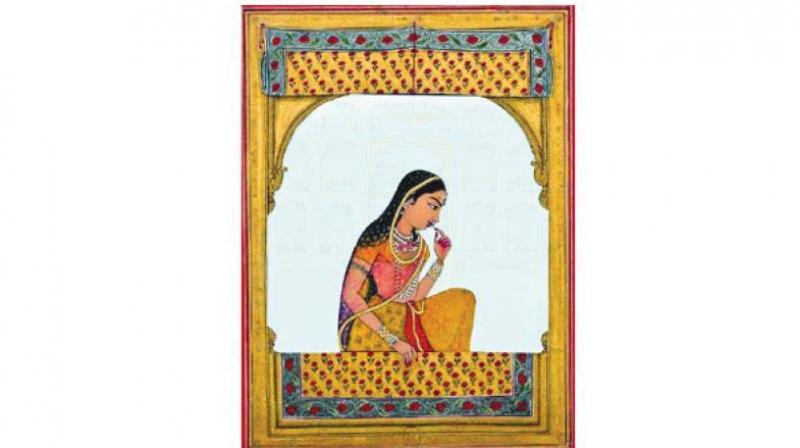Padmavati not as lucky as Joan of Arc
Can we imagine a film showing the Maid of Orl©ans frolicking with English soldiers?

At its core, the current controversy over the film Padmavati is a struggle between left-liberals and nationalists. Falsely depicted as an issue of freedom of expression, it is anger at the attempt to distort Indian history by legitimising a particular version created by a cabal of left-liberal historians. Joan of Arc (French: Jeanne d'Arc, January 6 c. 1412 – May 30 1431), is considered a heroine of France for her role during the Hundred Years war between the English and the French. She fought bravely for her country but was captured by the English and burned at the stake on May 30, 1431. She was later canonised as a saint, to become St Joan. Three separate ships of the French Navy have been named after her, including a helicopter carrier in her honour. France commemorates her memory with a civic holiday on the second Sunday of May.
Rani Padmavati, a queen of Chittor in the 14th century, preferred death to dishonour, thus inspiring Rajputs to fight to the finish when faced with the wrath of the Delhi Sultan, Allauddin Khilji. The Padmini palace in Chittorgarh fort and the ‘kund’ (fire place) where she performed ‘jauhar’ (self-immolation) with many other brave ladies is a site of great reverence for all Indians. Padmavati has not been as fortunate as Joan of Arc. Self-styled ‘eminent’ historians (concentrated in Dilli) doubt if such person ever existed. Their sole evidence is a fictional poem written nearly 200 years later by Malik Muhammad Jayasi. So the defenders of the freedom of expression ask how a movie on a fictional personality can be ‘defamatory’. According to them, Bollywood is within its constitutional rights to show titillating dance sequences/ dream sequences etc. Can we imagine a French movie showing Joan of Arc in a dream sequence frolicking with English soldiers?
The producer-director of the film on Padmavati has a reputation for reducing historical character like Bajirao to a lover boy and showing unreal dance sequences in his film on Bajirao. Since Bajirao belonged to a tiny community with no political clout, he got away with it. This time it seems he has taken on a more formidable adversary.
The whole episode raises some fundamental questions. The doubt about the existence of Rani Padmavati as a historical figure is typical of the lazy historians of India. Most Indian historians are like a man searching for a lost needle on a dark night only under the lamp, who, when asked why he ignored other areas, answered that this was the only place where there was light! Most Indian historians take this route and rely on easily available Western sources (mainly in English). Those who cite the sole evidence as a poem by Malik Jayasi totally ignore the Rajput sources and historical memories of generations that have preserved the past. This reliance on public memory is necessitated due to the fact that the written records of any kind of that era were destroyed when the Mughals captured Chittor fort in 1567. This author faced similar problems while working on Maratha history as the records of Shivaji the Great were similarly burnt when his capital at Raigad fell to Mughal general Zulfikar Khan in 1689, after Shivaji’s death in 1680. The only way to piece together the story of Shivaji and his Hindavi Swarajya was to collect documents scattered all over Maharashtra in the form of his letters to various generals and other rulers. But this needs diligent work, generous government support and an open mind, sadly lacking in Indian historians. In addition, after the horrible communal riots in Jabalpur in 1961, Pt Jawaharlal Nehru, our first Prime Minister, believed that history was the culprit. His solution was to hand over historical research to leftists with a clear mandate to ‘de-communalise’ history rather than have an open discussion and effect a closure. History as a search for truth was foreign to these individuals.
In 1961, a massive campaign began to whitewash the Islamic genocide of Hindus in North India. The sidelining of Padmavati was part of that process. The last 10 years have seen the Nehru-initiated process reach its nadir when the Indian government submitted an affidavit in Supreme Court in connection with the Ram Setu that Ram was a fictional character. These worthies did not explain how a fictional character (Ram) and fictional event (building of bridge across the straits) are depicted in murals in faraway Indonesia, at Prambanam (near Yogyakarta in Java) dating back to the sixth century. The Dilli elite has accepted the Western notion, ours is history, yours is mere mythology.
Indian intellectuals unthinkingly parrot the Western notion of pre-history and history. All events and personalities before Jesus Christ are labelled prehistory; even Gautam Buddha is a mythical character. What we are witnessing today, including the row over Padmavati, is a revolt against this blatant distortion. Unfortunately, the zealots amongst Indians have done immense harm to this cause of restoring the history of our land by failing to separate myth from history. In addition, politics and violence has begun to play a role in determining the past. In this process the pendulum seems to have swung from the whitewashed history of the Nehruvian era to the saffronised version today.

